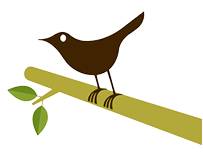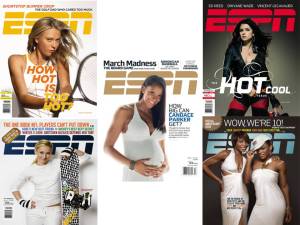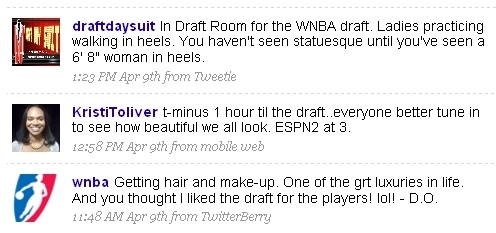This example comes from Fox Soccer.com titled Soccer Wives and Girlfriends. Why this is on a sport website is interesting food for thought. I looked for “Soccer Husbands and Boyfriends” on the WPS website but (thankfully) did not find any. It is picture essays like this that relegate women to the sidelines. Not to mention only including pictures of male soccer player’s female partners and companions is not very inclusive.
Example of Reproducing Traditional Gender Roles in Soccer
12 10 2009Comments : 1 Comment »
Tags: professional sport, sexualization, soccer, WPS
Categories : sport media
Thoughts on Bras, (Soccer) Balls, & Bikes
10 07 2009A few random things to think about over the weekend:
 1. As the 10th Anniversary of the 1999 Women’s World Cup in upon us, pay attention to how the media constructs this historic event. Will the focus be on a) the US win and competitive achievement, b) Brandi Chastain’s offing-the-soccer jersey to expose her Nike sports-bra (see the NCAA Double-A Zone), c) the “girls of summer” (i.e., the wholesome, attractive, All-American darlings that everyone fell in love with) many of whom are now mothers, d) how the historic event gave notice that people DO like to watch women’s sports (especially when it is promoted in the media and marketed) (see Christine Brennan’s USA Today column, e) how the team provided role models for young boys and girls, or f) spawned two women’s professional soccer leagues (see WPS) …..or perhaps some of all of the above? I’ll be curious to see what dominant messages arise.
1. As the 10th Anniversary of the 1999 Women’s World Cup in upon us, pay attention to how the media constructs this historic event. Will the focus be on a) the US win and competitive achievement, b) Brandi Chastain’s offing-the-soccer jersey to expose her Nike sports-bra (see the NCAA Double-A Zone), c) the “girls of summer” (i.e., the wholesome, attractive, All-American darlings that everyone fell in love with) many of whom are now mothers, d) how the historic event gave notice that people DO like to watch women’s sports (especially when it is promoted in the media and marketed) (see Christine Brennan’s USA Today column, e) how the team provided role models for young boys and girls, or f) spawned two women’s professional soccer leagues (see WPS) …..or perhaps some of all of the above? I’ll be curious to see what dominant messages arise.
 2. The Tour de France is underway! Will Lance Armstrong really win it yet again? It got me thinking…why don’t women ride in the Tour de France? I did a little sleuthing and found no real answers but there IS a race called Le Grand Boucle (“the great loop”) which is been held off and on roughly over the last 15 years. The women’s race is shorter, has varied in the number of stages (the men’s race has 21), and the 2009 race will be just four days long “due to organizational difficulties” (according to Wikipedia..take it for what you will). If you know French, you can see the official website of Le Grand Boucle…je parlez un peu francais. It makes me think that the exclusion of women in the Tour de France is arbitrary, and the shorter “lesser than” women’s race, serves to perpetuate existing and historical gender hierarchies in sport that privilege male athletes.
2. The Tour de France is underway! Will Lance Armstrong really win it yet again? It got me thinking…why don’t women ride in the Tour de France? I did a little sleuthing and found no real answers but there IS a race called Le Grand Boucle (“the great loop”) which is been held off and on roughly over the last 15 years. The women’s race is shorter, has varied in the number of stages (the men’s race has 21), and the 2009 race will be just four days long “due to organizational difficulties” (according to Wikipedia..take it for what you will). If you know French, you can see the official website of Le Grand Boucle…je parlez un peu francais. It makes me think that the exclusion of women in the Tour de France is arbitrary, and the shorter “lesser than” women’s race, serves to perpetuate existing and historical gender hierarchies in sport that privilege male athletes.
Comments : 6 Comments »
Tags: 1999 Women's World Cup Anniversary, Brandi Chastain, female athletes, Lance Armstrong, Le Grand Boucle, marginalization, professional sport, sport, sport fans, sport media, Tour de France, women, WPS
Categories : sport marketing, women & girls in sport
Marketing Sports: “Wine & Pampering” v. “Beer & Back Waxing”
16 04 2009So after posting my last blog “Are Women Sport Fans?” I had a couple conversations with colleagues about female sport fans and how we “market” sport to women which spurred some additional thoughts. As I mentioned previously, females comprise 53% of WNBA and one-third or more of all MLB, NBA, and NHL fans.
Have you ever wondered about the typical ways women are “enticed” to attend professional men’s sports(i.e., “wine & pamper yourself events” that also teach women the rules of the game? This assumes that women don’t attend sports purely because they love the game, know the rules, follow the stats, or are passionate about their favorite team and player(s). Women ARE sport fans…but we so seldom see them in the sport media it is assumed they don’t exist. It also assumes that women don’t know the rules of the game and therefore don’t attend for that reason. If women just KNEW the rules it would increase their likelihood of attending! Women have to be lured to attend sports through things society tells them that women like…manicures, being pampered, wine tasting, and hanging out with the girls.
So let’s apply similar logic to attracting male fans (the coveted sport demographic) to women’s professional leagues, for example the WPS or WNBA. Are parallel events like “beer & back waxing” days offered for men? Or days that teach men the rules of the game? No? If not, then it must be assumed that all men are already sport fans and KNOW the rules the game. But this hasn’t translated into increasing numbers of male fans….yet. What do you think is the most effective way to increase the number of male sport fans at womens’ sports?
Key point: one-third or more of sport fans are comprised of females….men’s and women’s sports NEED female fans to survive! What if that one-third of the female fan base stopped attending men’s sports? To ensure the survival of women’s pro leagues that many of us are passionate about, is not the sole responsibility of female fans. Men’s pro sports rely on both male and female sport fans for sustainability, the same applies for women’s pro sports.
I still believe we haven’t gotten it right….yet. What does effective sport marketing to females look like? What does effective marketing of women’s sport look like? To get us started in answering these questions I think back to the May 26, 2006 and an October 9, 2006 Sport Business Journal articles written by a former colleague.
Comments : Leave a Comment »
Tags: female athletes, gender, marketing, men's sport, NBA, NFL, professional sport, sport consumers, sport fans, sport leagues, sport marketing, WNBA, women, WPS
Categories : sport marketing, sport media, women & girls in sport








